Last Updated: February 14th, 2020
Engagement sessions are the perfect way for a photographer to connect with a couple in a low stress and fun environment. Most of the time, we photograph engagement sessions for couples who have booked a wedding photography package with us – so this might be the first time we’re meeting in real life, too.
Our engagement photography tips have been put together based on all of our experience shooting them over the years – and we hope it helps you as a photographer to better capture beautiful images for your own couples.
Engagement Photography Tips: How to Take STUNNING E-Session Photos Every Time
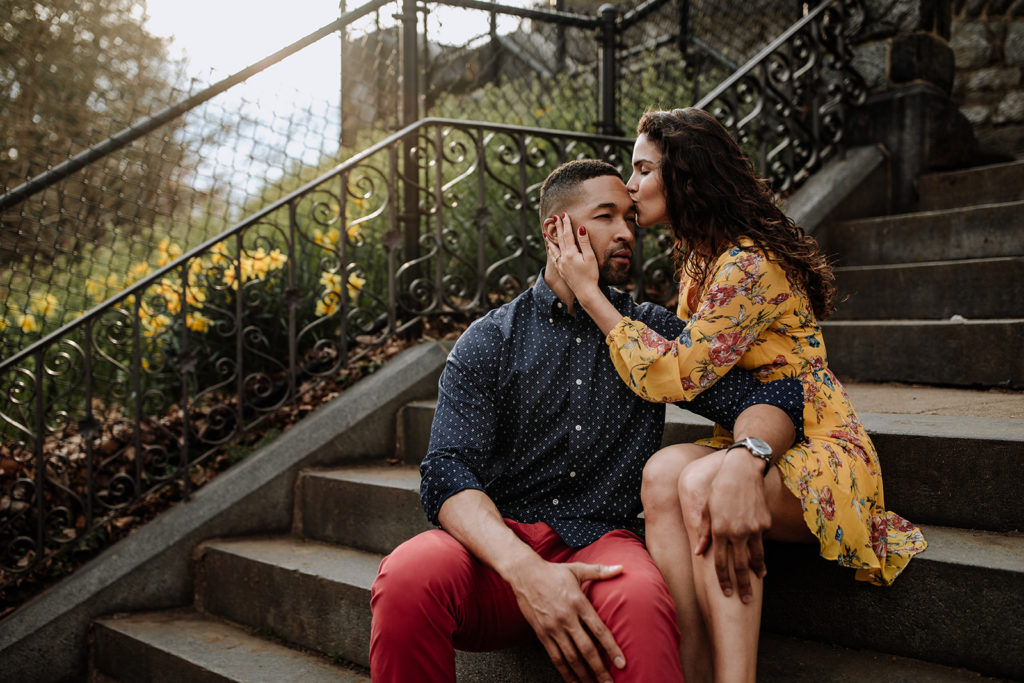 Our engagement photography tips will begin by helping you get informed about things you should be aware of before the shoot, then will transition to talking about things that will help you take stunning photos during the session.
Our engagement photography tips will begin by helping you get informed about things you should be aware of before the shoot, then will transition to talking about things that will help you take stunning photos during the session.
1. Keep things authentic to the couple
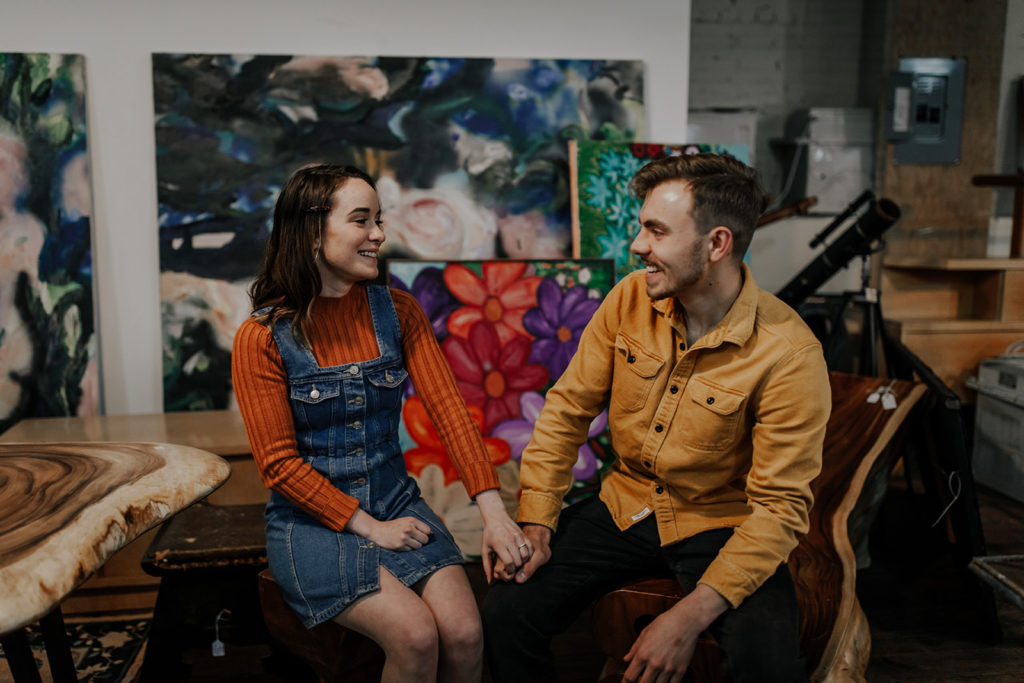 In our approach to photography – authenticity is key!
In our approach to photography – authenticity is key!
This is usually something that photographers understand, but the trouble comes in figuring out how to make sure this is actually expressed. This is especially true when working with clients who just want to try an emulate things that have already been done (we can probably thank Pinterest for this trend!).
Authenticity in engagement photos really boils down to making sure you are capturing the personalities of your couple in a space that is comfortable and reflective of them.
In the next couple of engagement photography tips, we’ll show you how you can better connect with your couple authentically, so you are getting their photos just right!
2. Ask yourself: “What would I want to see in my own engagement photos?”
Since we’ve photographed so many engagement sessions over the years, we’ve often had to go back to square one to make sure we’re on track. We ask ourselves this question often to remember that engagement photos should really be simple, fun, and reflective of the couple.
In our case, we go way back to 2015 when we had our own engagement session before getting married in the fall of 2016. While not every wedding photographer is married or even in a relationship, this personal experience has helped us often to remember exactly what it was like.
In a funny twist, we are photographers who aren’t particularly fond of being in front of the camera ourselves. While we push outside of our comfort zones once in a while and subject ourselves to being photographed – we understand that, for most couples, this probably isn’t their favorite thing in the world.
Just because you start with this mindset, doesn’t mean an engagement session can’t go to really fun and surprising places.
Ultimately – what we wanted from our own photos was just an accurate reflection of us and a different perspective than we usually get by trying (and often failing) to take selfies on our phones.
3. Select a great location
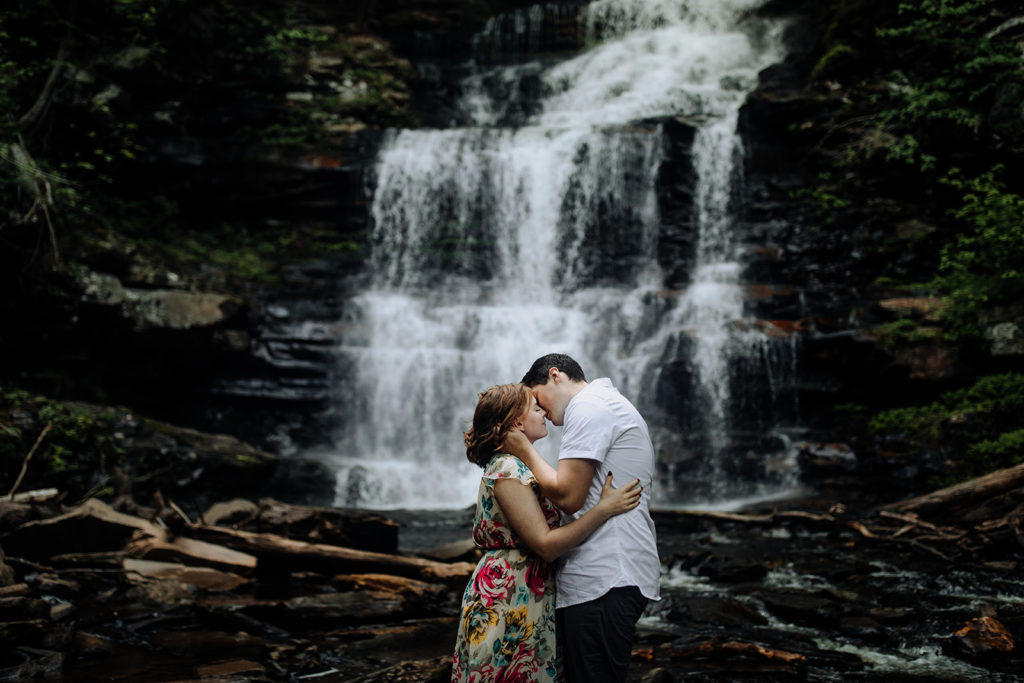 The choice of location for all of our couples is either very easy OR quite challenging.
The choice of location for all of our couples is either very easy OR quite challenging.
Sometimes, couples have a place in mind already – often an area they visit frequently or that’s really resonated with them in the past.
In other cases, couples have no idea where they want to have their pictures taken. A lot of times – people tend to overthink the location!
We can absolutely understand the desire to have photos that are perfect – and selecting a great location will help play a role in this.
Our best tips for finding a perfect location for those clients who don’t know where they want their engagement photos include:
- Ask them what features they want to incorporate. Most important to us is to narrow down if they want a natural aesthetic (so: woodsy, waterfalls, etc.) or an urban aesthetic (downtown city vibes).
- Prepare a list of go to engagement photography spots. Think state parks, café shops, and other locations in your area.
- Remind your clients that beautiful photos can be created anywhere. As photographers, we have the gift of being able to isolate great parts of an environment, and leaving out the less attractive parts. Some locations are just beautiful every where (we saw this in Iceland as an example). Other spaces, particularly in cities, will have some rough, grungy, and dirty spaces right next to great looking things like artistic murals and cool architecture.
- Show examples of past work at certain locations you’ve been too. Having an engagement photo portfolio to show off can help a new couple get an idea of what their pictures would look like in the same space.
- Let your couple have the final say. It’s great to provide recommendations – but we suggest never being the one to dictate where a shoot will take place. It’s important for your client to be happy with the choice – so give input, provide options that you know of, but leave it to them to decide what they want exactly.
4. Keep in mind private property and permit requirements
Sometimes, requests will come in to take engagement pictures at private establishments like a local coffee shop. This is actually very common – and can be a great change of pace for a photographer.
It’s important to keep in mind, though, that photographers are not always welcome to use these spaces.
It’s a good idea to send a message (or call) in advance to confirm that it would be okay to take engagement pictures. You should also verify if there are any rules or requirements you’d have to keep in mind. In some cases, you might be asked to pay a fee to use the space as well.
As another example, we recently learned that there are permit requirements to shoot in a lot of big cities. We asked other wedding photographers about this on Reddit – because it was inspired by one of our couple’s wanting to take photos in Philadelphia.
It turns out, we have to get a permit (which costs in the ballpark of 50$ – 150$ an hour depending on the specific location) for any commercial photography (including wedding and engagement) that is on property of the Philadelphia Parks Department (source) – which is the vast majority of the city.
Whether it’s fair or actually justified is a separate question, but we get permits to make sure we don’t run into any hassle when shooting in spaces like these.
Unfortunately – these kinds of costs are also passed along to our couples, so we always try to be upfront about this & offer alternative options if possible.
5. Remember to charge for travel
Every engagement photographer’s tolerance for travel will vary. Our opinion on travel fees is that we charge them when the amount of travel is very time consuming.
At the end of the day – our time is valuable, too. So, if we’re going to spend 6 hours in a car – you better believe we’ll be charging for it.
We actually wrote a whole article talking about how we put together travel fees for our photography clients – but it boils down to a couple simple ideas:
- Offer free travel in a limited radius around your area
- Charge a fee per mile over your “free” radius
- Add extra fees for parking and tolls (if applicable)
If you’ve incorporated your business, you should also be using a mileage tracking app so you can earn a tax deduction for all the driving you do. We use MileIQ for this – a really great and consistent app that automatically tracks our mileage. For about $60/year, we earn this money back (and then some). Just last year, we earned a $4,500 tax deduction because of the amount of traveling we put in – that’s a big deal!!
6. Have the right gear for the shoot
Photography equipment for an engagement session can be as minimal or complex as you need it to be.
There is no right or wrong – but keep in mind the things you bring along should be things you also plan to use.
In our early and budget restricted days, we would photograph entire engagement shoots – even weddings – with a 50mm lens. Over time, we invested in more gear to help us get better quality images & take more control over the look of our photos by expanding our camera lenses and adding a flash kit.
You can (and should) read through our Recommended Gear pages if you need help figuring out what things you will really want to have along.
For beginner photographers starting to shoot couples portraits, we’d suggest at least having 1-2 portrait lenses anywhere from 35mm – 85mm (full frame). Wider (like a 16mm) and tighter (like a 200mm) are cool in their own ways – but not the most “necessary” of investments for engagement shoots.
If you’re a pro photographer already with a nice set of gear, you might have some fun experimenting with unique equipment like a tilt shift lens. The Canon 24mm f/3.5 TS-E II lens is one example!
Pro tip: one other mistake that is easy to make as you start to collect gear is bringing too much along. We’ve been known to carry a 30lb backpack filled with our gear – but for some sessions a lot of this is just unnecessary weight. Before every shoot, we always ask ourselves…are we really going to need the 70-200 telephoto lens for this?
7. Make small talk and connect on a personal level
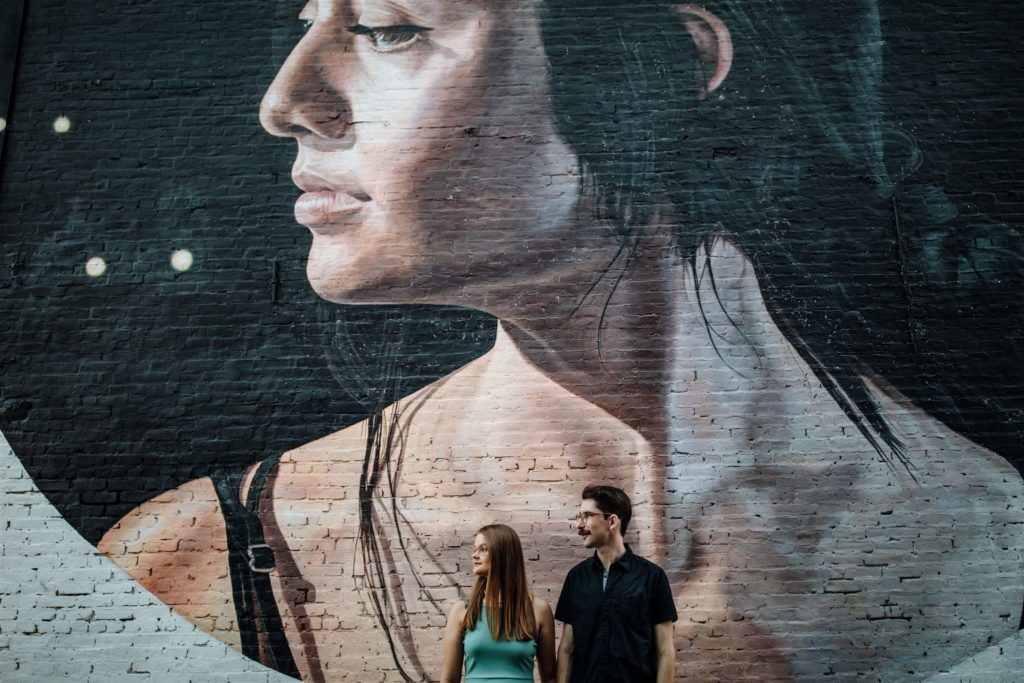 Okay – so you finally meet up with your clients on the day of their engagement session. This is super exciting!!
Okay – so you finally meet up with your clients on the day of their engagement session. This is super exciting!!
One of the biggest keys to a great engagement session is being able to get your couple comfortable being around you.
Most of our engagement sessions begin with 5-10 minutes of getting to know each other. A lot of times, this is done while walking to our starting location.
As the shoot goes on, constantly be chatting it up. This will give you deeper insights into who your clients are as people, allow them to connect with you, and even build a trusting relationship that will be great for when the wedding day rolls around.
Talking tip: We’re relatively introverted by nature, and engaging in small talk has never been something we’d call “easy.” Through professional photography, we’ve learned to open up in a lot of surprising ways. It turns out, talking to people is very easy, and breaking down these super simple barriers is not usually that hard. The easiest way to do this? Just ask questions!
Some of our conversation starters when we’re not sure what to talk about:
- How did you meet?
- How did your proposal happen?
- What are your favorite things to do together?
- Do you like to travel?
- Any good movies/TV shows/books you’ve been checking out lately?
8. Move around to change perspective
One of the great engagement photography tips we can offer is to simply move around!
As photographers, we can sometimes fixate on wanting to get the perfect pose. In reality, the pose your couple is already in can probably be milked for a lot of photos just by moving around them.
Moving backwards will give you a wider shot with more of the environment in the frame. Moving forwards will get you a tighter shot. And moving around the couple in a circle would result in a lot of unique perspectives.
9. Use a mixture of lenses for most diversity
 Your choice of camera lens(es) will play a HUGE role in the perspective you bring with your photography.
Your choice of camera lens(es) will play a HUGE role in the perspective you bring with your photography.
As we mentioned earlier, beginner engagement photographers will have no issue if they are only able to work with 1 or 2 lenses – but as you can afford more, it’s worth picking up others for this purpose. When we added a really wide lens to our kit, it absolutely changed our approach to composition. Not to mention – it impacted how we viewed the world around us altogether.
Lens Types and How They Affect Your Engagement Photos:
- Ultra-wide lenses. <16mm. These really wide lenses are ideal for capturing huge landscapes. They are not too commonly used for engagement photography because they will greatly distort the couple in your frame – but might be ideal if you’re shooting in a space that is HUGE like the Grand Canyon.
- Wide lenses. 16-35mm. These lenses are more “reasonable” (in our opinion) and allow you to capture large landscape shots without being We love our 16mm in particular for this, and it’s distortion can be used to interesting effect at times when close up.
- Standard lenses. 35-50mm. You need at least one lens in this range. The 50mm focal length is most comparable to what the human eye sees (source), so it’s the most accessible type of photography.
- Portrait lenses. 50-135mm. Lenses with longer focal lengths are perfect for engagement portraits because they allow you to create more separation between the couple and the background. Most of our favorite couple’s photography shots are taken on an 85mm prime lens.
- Long lenses. >135mm. Longer lenses are an excellent option for portraits when you have space to use them. Our 70-200mm lens when zoomed fully in to 200mm is one of our favorites – it’s just not possible to use it in a tight space. When using a longer lens like this, you increase the compression and separation between the couple and the background.
Camera Lens Chart:
[table id=1 /]
10. Get some “safe” shots
 One of the first photos we take during our engagement sessions (and occasionally throughout) is the…” stand here and look at the camera” …shot. You might be thinking…”but that’s boring!” And…yes…you’re absolutely right.
One of the first photos we take during our engagement sessions (and occasionally throughout) is the…” stand here and look at the camera” …shot. You might be thinking…”but that’s boring!” And…yes…you’re absolutely right.
We take these photos not for ourselves, and sometimes not even for our couples.
We take these simple and plain images for friends & family of our couple who may just want to have a simple photos to look at and even print out to hang up in a family room. You just know their grandparents are going to want to see this sort of thing!!
It’s important to keep this in mind when taking engagement and wedding pictures. They are cherished by a lot of different people, so providing a great mixture of simple & artsy shots is the best way to make sure everyone LOVES your photos.
11. Experiment a whole lot, too!
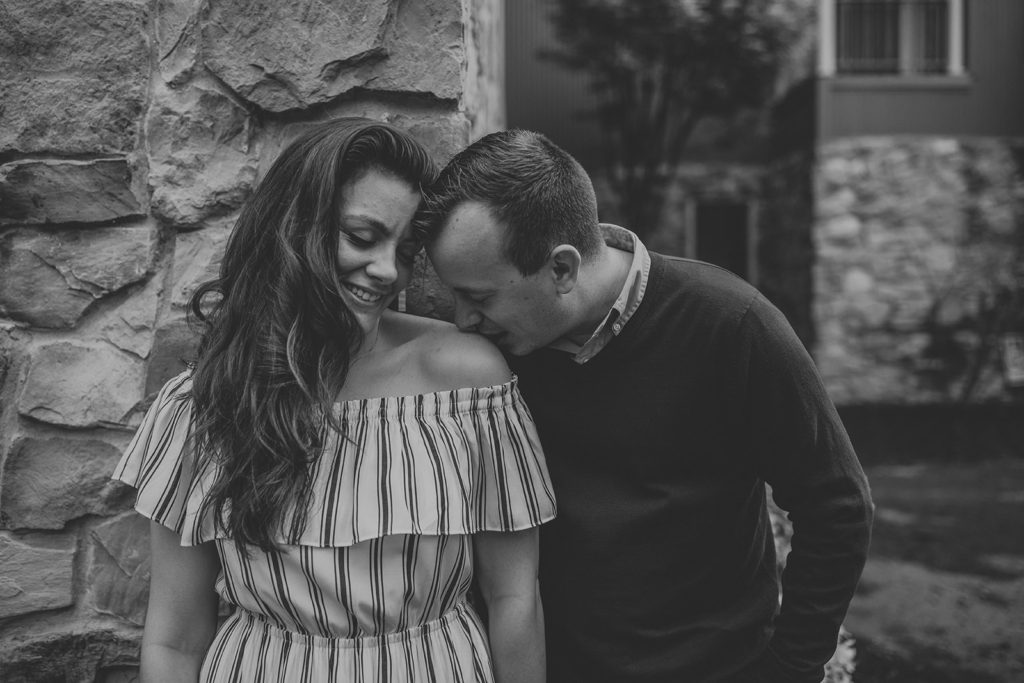 Now for the fun part!
Now for the fun part!
We would argue that many of the most amazing photographs in history are the result of intentional experimentation.
What we mean by this is that you should…
- Aim to try out new things and do things you might not normally
- Ground your experimentation in some structure
In engagement photography, this might mean trying out a different pose or compositional perspective. This may also mean just getting out of your comfort zone to do things that make you uncomfortable or even make you look silly.
However you choose to experiment – you don’t want to do it mindlessly.
We often rely on basic photography rules to help us put together an interesting composition.
Our experimentations may come from using these rules in different ways – like taking the simple concept of leading lines and looking for more complex & intersecting lines in the environment.
They may also be the result of subverting expectations – like using a leading line to take the viewers eye no where interesting while the standard rule would suggest it should go to a point of interest.
As an artist – you get to decide exactly what your experimental photography will look like!
12. Put together a plan
We talk a lot on this website about how putting together wedding timelines help us to effectively tackle photographing the big day for our clients. The same is true for most engagement sessions.
While you do not need to go to the level of detail you’d want for a wedding, having a timeline for more complex engagement shoots that might involve multiple locations, outfit changes, and so on – is valuable.
For more simple shoots, like one being held at a local park you are more than familiar with, at least have a plan in your head of where you are wanting to shoot.
13. Scout your location(s) beforehand
 More often than not, we like to check out places we will be shooting engagement photos to help us get a lay of the land. This will sometimes mean showing up a little earlier on the day, or making our way to a location days in advance.
More often than not, we like to check out places we will be shooting engagement photos to help us get a lay of the land. This will sometimes mean showing up a little earlier on the day, or making our way to a location days in advance.
This is not usually necessary in locations that are smaller or that you are very familiar with.
What we are mostly looking for are…
- Points of interest
- Interesting natural features and architecture
- Off the beaten path environments
- Cool compositions
When shooting large environments like Philadelphia (a whole city) or even Longwood Gardens (a great engagement photography location in PA we frequent) – having knowledge of where certain things are and how to get to them easily is invaluable. This is especially true as you will often find yourself racing & chasing the light.
14. Golden Hour is your friend
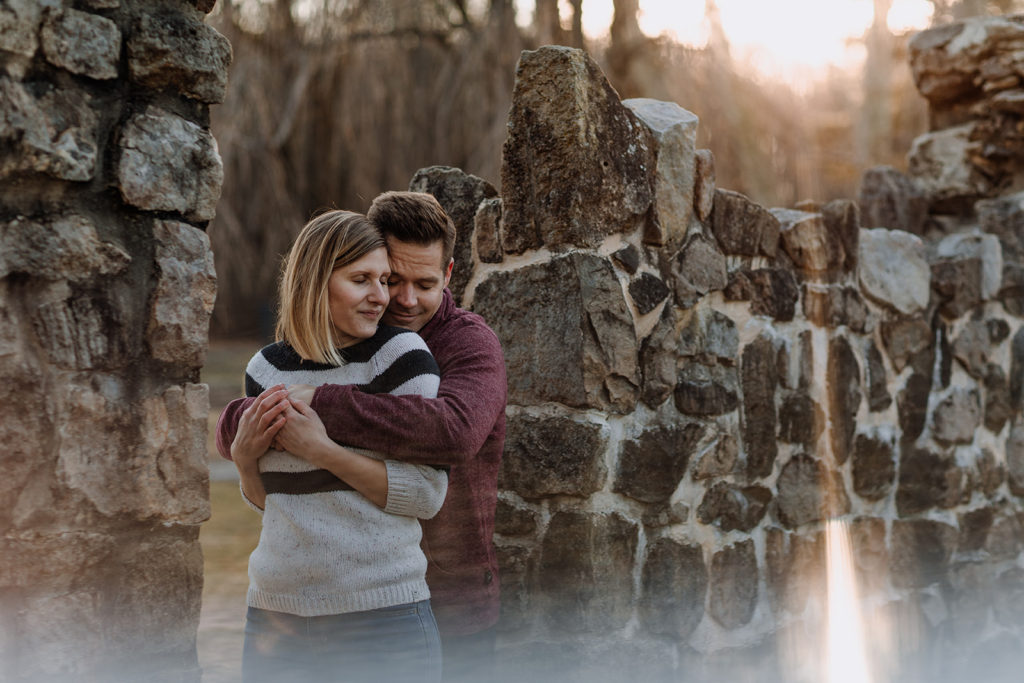 Scroll through your Instagram feed of engagement photographers and do you notice a trend?
Scroll through your Instagram feed of engagement photographers and do you notice a trend?
Beautiful light helps to make beautiful photos.
Hands down, the best photographs are most frequently taken during Golden Hour – sunset and sunrise time.
Scheduling engagement sessions with this timing in mind will help you to create great looking photos with relative ease. Sure – this isn’t the only factor that makes a good photo, but it definitely contributes!
We would say that about 95% of our engagement sessions take place during Golden Hour. Some will run into Blue Hour (the time after the sun sets). The other 5% happen at different parts of the day mostly due to scheduling conflicts.
15. Our trick: find the light (with your hand)
Next time you are outside – stick your hand out in front of you with your fingertips pointing up.
Is the sunlight on the part of your hand you can see, or is it cast in shadow?
This is a simple method to “find the light” – since you will normally want to photograph your portrait subjects with light illuminating their faces.
We regularly use this trick when finding the optimal position for our clients. You would think it would be easier to know where exactly the light is coming from, but it can be a tricky thing.
Pro tip: using your hand to find the light is ideal for natural light photographers in particular. By using a cheap reflector or a flash setup, you can be the one to take total control over the light.
16. Keep an eye on the weather
Outdoor portrait photography is our preference – but we know that when shooting couples it’s not always going to be possible if the weather looks like it will be bad.
Leading up to an engagement shoot, we regularly monitor the weather using sites like NOAA and WeatherBug. What is especially important to check is the hourly weather reports – as you might see a 100% chance of rain for a particular day, but it turns out it will only rain for a few hours in the morning.
With this said – a little rain can’t be all that bad, right?
17. Bad weather = cool engagement photos
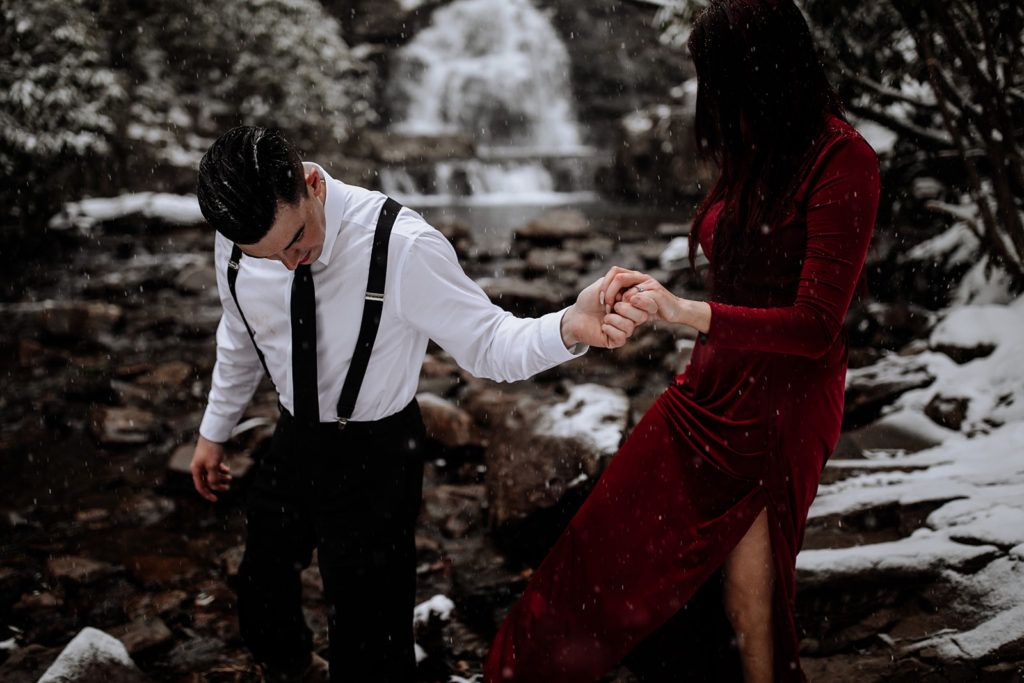 Absolutely! Some of our favorite portrait photos have been taken in the rain and snow.
Absolutely! Some of our favorite portrait photos have been taken in the rain and snow.
As a photographer, bad weather can make taking pictures challenging, but it can also lead to very rewarding images.
If you are wanting to capture moody and romantic couple’s portraits – a bit of rain and snow are the perfect way to add to this feeling. Rain can take your couple from 0 – The Notebook kissing scene levels of passion real quick.
Related: A Guide to Taking Modern Black and White Portrait Photography
18. Be careful of extreme heat and bitter cold
Living in Pennsylvania, we’re used to seeing all types of weather. As we write this, we are just coming away from a 110 degree (F) day in mid-July. Oh – and we had an engagement shoot – and it was rough.
Not only can high heat and very cold temperatures impact you and your gear, but it also will impact the people you are photographing. They may feel tired and groggy – not things we often want associated with engagement pictures. Even worse – they could work up a sweat, which shows in their images. They might even feel like they have to rush to get to a space that is a more reasonable temperature – also an unfortunate side effect.
If you see it’s going to be a really extreme temp, consider rescheduling or finding a new venue for your engagement shoot. If not for yourself, for the sake of your couple’s photos!
19. Think like a videographer (sometimes)
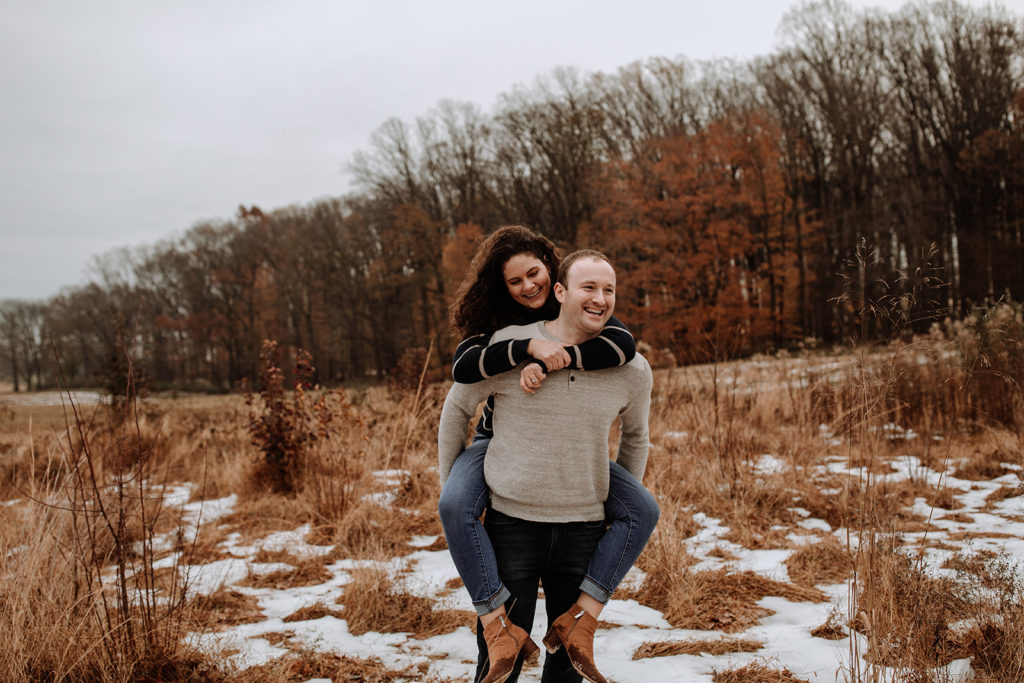 One thing that separates video from photography is movement.
One thing that separates video from photography is movement.
Having worked with many videographers and film makers on many occasions, we’ve taken a liking to how they work. Instead of just having a couple stand there, they are constantly having the couple do something to add movement to their scenes.
While photography is about the still frame – by having your couple perform simple actions like walking towards the camera, you interject movement into your photos.
This movement will help the couple to be more authentic and open up to the camera because it allows them to stop thinking about having their photos taken, and start thinking about the specific action at hand!
20. Tell your couple what they can expect at the start of their session
In addition to making some small talk, we like to start off every engagement session by letting our couples know what they can expect. We try not to let this drag on too long or feel overwhelming, but the basic things we like to cover:
- We want this session to be about you
- We want you to have a fun time being together
- We will give you guidance when needed, but otherwise do what comes naturally
- …And the first 5-10 minutes are usually a little awkward, it will pass soon 🙂
21. Be an encouraging and positive voice
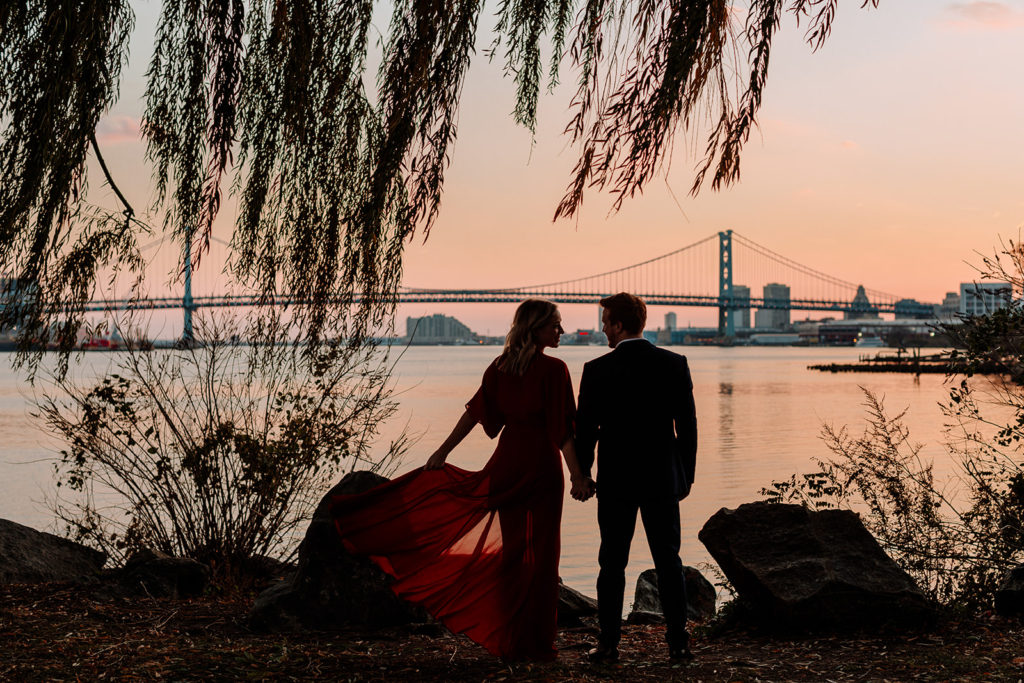 As the people behind the camera, it’s easy to forget the anxiety and self doubt other people may be feeling. It’s so easy to be self-conscious and put ourselves down – we’re guilty of it ourselves.
As the people behind the camera, it’s easy to forget the anxiety and self doubt other people may be feeling. It’s so easy to be self-conscious and put ourselves down – we’re guilty of it ourselves.
We want engagement photography to be a positive experience, and the resulting images to be something people can be absolutely happy with.
Outside of the actual images you are taking, bringing this positivity to your sessions is one of the best things you can do for your couples.
Constantly reassure them that they are looking great, and the photos are turning out beautifully. Show them sneak peeks on the back of your camera screen, too, so they can not just hear what you’re saying – but see with their own eyes.
One thing to remember: always let your feedback be authentic. In the pursuit of being encouraging, you can also come across as fake (let’s be honest for a second).
One way to help you maintain authenticity is to point out specific things that they are doing that is worth encouraging.
Which sounds better to you?
“Wow, you guys look great!”
OR
“You both picked great outfits for this session and they are going to photograph awesomely with you in ’em!”
(Let us know in the comment section at the end of this post!)
22. Allow an outfit change (or two)
Engagement photography instantly gets some diversity when the couple changes up what they are wearing.
It’s extremely common for couples to want to bring two sets of clothes – both a casual and dressy looking outfit. Just make sure you leave some time in your schedule for them to actually get changed!
But what do you do if there is no where for them to change? When shooting in a city, this isn’t normally a problem thanks to public restrooms. But, in more remote spaces, it can seem like a logistical nightmare. We’ve had clients just get changed in their cars (normally okay), but recently learned about portable privacy changing stations like this one that’s a real game changer when in more remote locations or if the couple wants more privacy. For like $35 bucks – that’s a great deal!!
23. Be confident and take charge
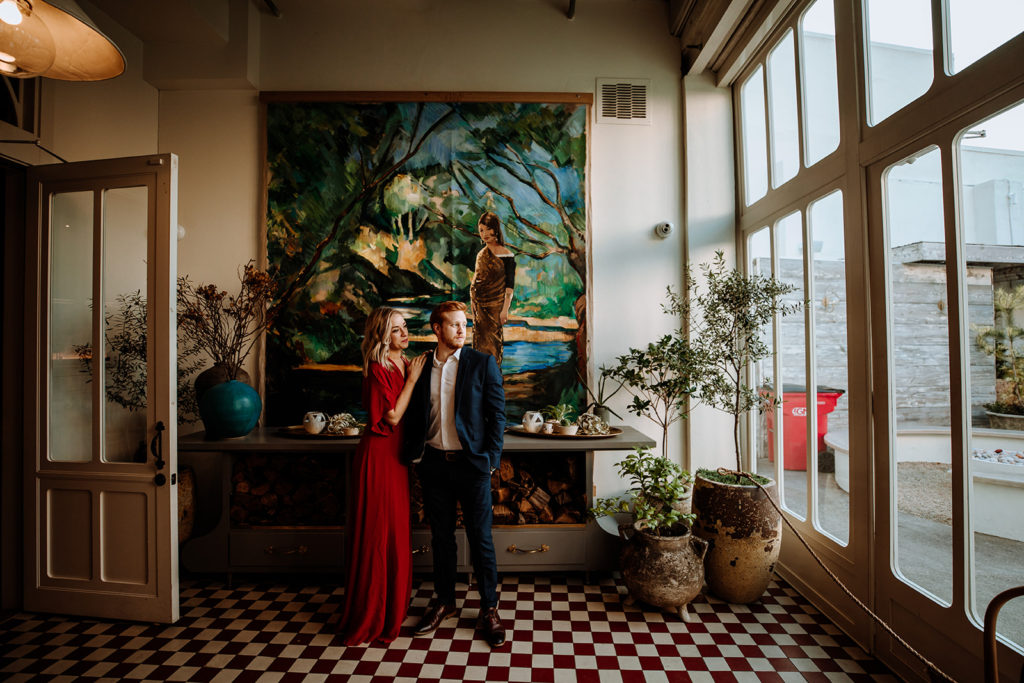 The best engagement photographers have the ability to take control over their e-sessions instead of just letting them unfold on their own.
The best engagement photographers have the ability to take control over their e-sessions instead of just letting them unfold on their own.
If you aren’t feeling quite confident yet – just know that it is totally okay! The confidence comes with experience. We remember the awkwardness of shooting some of our first engagement shoots – and we definitely made a lot of mistakes in the process.
We must have shot over 50 engagement sessions up to this point (with many more lined up already!) – and this experience translates to a much better experience for our new clients. We are now extremely confident and capable in producing great photos over-and-over.
A few ways to start taking charge even in your first engagement shoot:
- Pose your couple – pick a couple poses you like, and stick with them
- Guide them into more flattering positions
- Get knowledgeable about controlling the light and taking pictures so you don’t have to think about these things so much in addition to posing and interacting with your couple
- Laugh off your mistakes – a part of confidence comes in how you handle doing the wrong thing 🙂
24. Suggest that couples turn their engagement session into a date night activity
We do this to help make engagement photos feel like more of an experience.
It really is the type of thing couple’s can turn into a larger date night so it’s this huge chunk of time dedicated to them.
A lot of the time, we’ll ask our couples…”Do you have any plans for the rest of the day/night?” Often the response is…”Yes! We’re going out to eat!”
It’s a simple thing, but helps keep your couples grounded in their photography being one beautiful aspect of their life together.
25. Incorporate children and fur babies
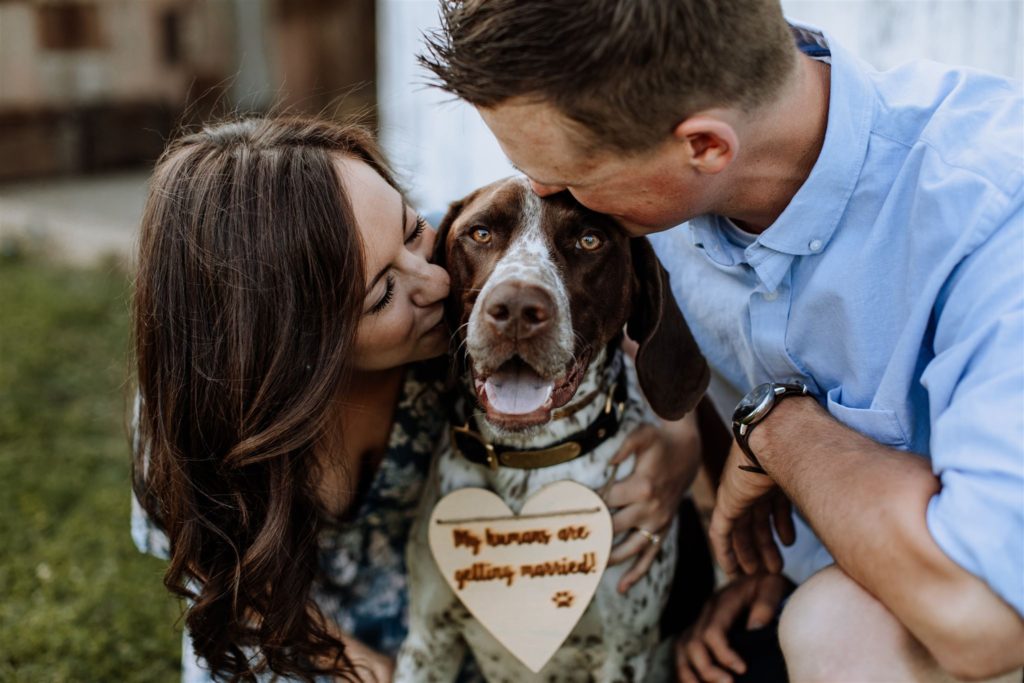 Photographing couples who already have children…or fur children…is extremely fun!
Photographing couples who already have children…or fur children…is extremely fun!
Most of the time, we only suggest to incorporate these other people (…and animals…) into a part of the engagement session. After all, these photos should be about the couple themselves, and evolving into a straight up family portrait session is a different thing entirely.
The most important engagement photography tip to keep in mind when adding kids and pets into the mix is simple: be patient.
If there is anything we’ve learned, kids and pets alike don’t always like following instructions. Learning to go with the flow and shoot candidly will help you get amazing images. Sometimes, letting the couple work with them is also a solid option.
Pro tip: you can often incentivize children who just aren’t having it by offering them a “reward” for posing for a photo (or series of photos). We’re not the type to suggest we’d try to bribe a kid or anything, but often enough telling them we’ll let them take some pictures with our camera (with our direct supervision) is an easy way to get them to relax and stand at attention. Not for everyone, and it does have some risk, but the smile on their face is always worth it.
26. Help your couple plan their clothing choices
Guiding your couples to finding the right clothing for their engagement session is a great way to help craft the image results before you even pick up a camera.
We always like to tell couples that they should always wear clothing that they are comfortable in. This is always 100% one of the most important tips we can offer when it comes to selecting what to wear for an engagement shoot.
However – this doesn’t necessarily mean “wear anything.”
More important than actual fabrics or anything like that is the color choices.
This is the most visual component of our clothing, and exactly what you will be seeing in the photos.
Because 2 people need to be dressed together for these portraits – we always make the following suggestions:
- Wear simple and natural colors
- Wear complimentary colors instead of matching colors
- Consider the environment you’ll be shooting in. If you’re being photographed in the woods during the summer where you would expect a lot of greenery, it’s best to not wear green.
- Use vivid colors (like red) to create more drama in your look
Keeping the line of communication open on this topic is helpful too – so tell your clients if they have any questions, to shoot you an email to help them pick the right clothes!
27. Use Candid Posing Techniques
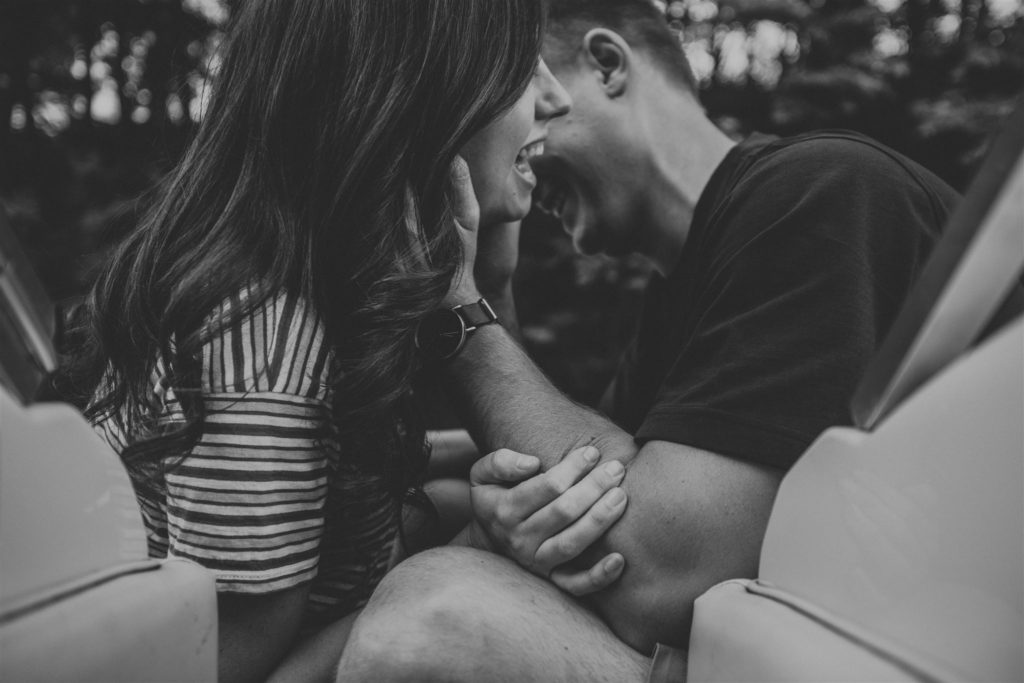 The most game-changing thing we ever did for our engagement photography (and wedding photography!) has been to adopt the “unposed” style of posing.
The most game-changing thing we ever did for our engagement photography (and wedding photography!) has been to adopt the “unposed” style of posing.
Put simply: this is an approach to taking couple’s portraits that involves the use of prompts to elicit natural responses instead of standard posing that would be associated with portrait photography from several decades ago.
If you love the engagement photos you have been seeing throughout this post taken by us – you need to check out Signature Edit’s Candid Couples Posing Guide. This is a 93 page digital guide filled with a lot of useful advice and prompts to help get your couple’s to laugh, share some romance together, and have fun! You can read our in depth review to see how we put it to the test, or head over to Signature Edit’s site to check it out now!!
We’ll never be photographers who use boring poses again!
SPECIAL OFFER!!
You can also get the Candid Couples Posing Guide in Signature Edit’s Photography Marketing School Unlimited.
This is the ULTIMATE package for those of you starting up your own photography business. It includes a ridiculous amount of materials to help you handle everything from email communications to learning the ins-and-outs of running your photo business. The marketing school will help you get more bookings, and grow your income significantly.
[maxbutton id=”12″ ]
28. Enhance the images in post-production
 Last, but not least, most modern engagement photography involves some post processing.
Last, but not least, most modern engagement photography involves some post processing.
By editing images, photographers are able to take even more control over the look of their photography.
Our approach to editing varies widely depending on the specific photos we are editing. Some just require color adjustments to be within our define style. Others require more involved touch ups to remove unflattering blemishes (like acne). We may also clean up backgrounds if they are messy. The extent to which you adjust and enhance your images is totally up to you!
We also use Lightroom presets to help us expedite this process along – otherwise our approach to photo editing would be extremely time consuming. These days, we use our own custom presets – but some great (…and inexpensive) ones to get you started include the Signature Edit’s Genesis preset pack.
Want to see the power of presets in action?
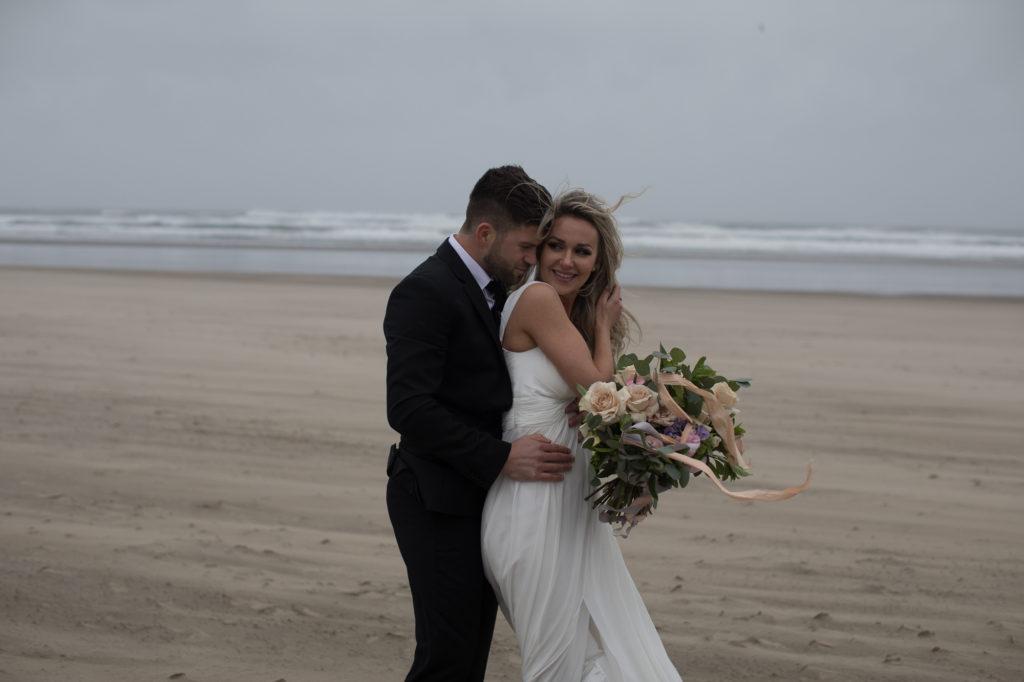
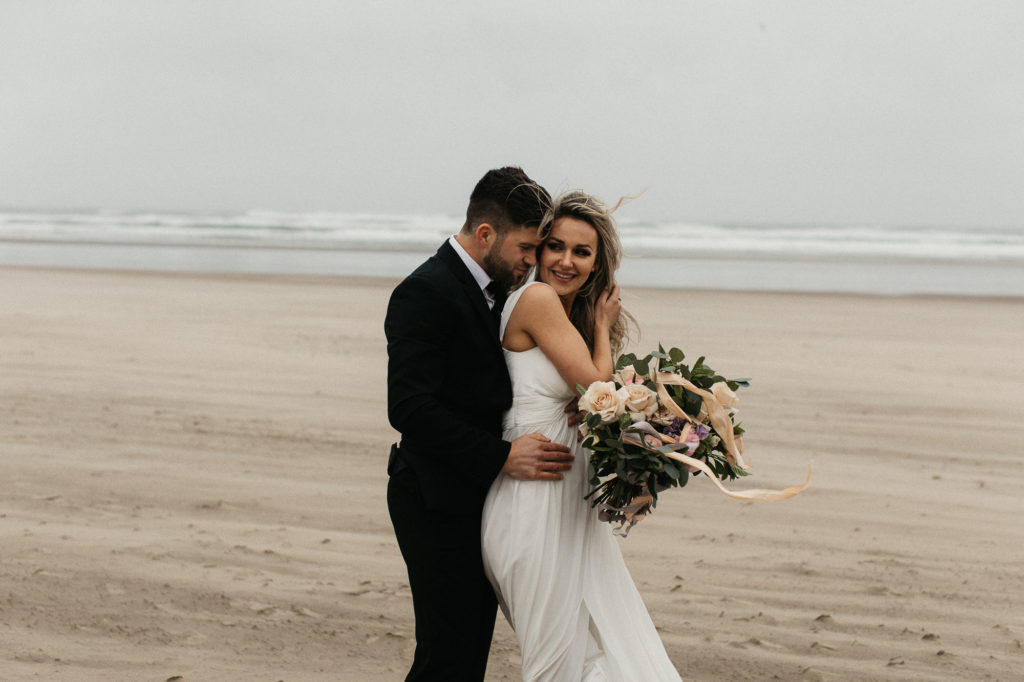
Bonus – Frequently Asked Questions About Engagement Shoots
We’ve collected a list of questions we are frequently asked by our couples and other photographers.
With so much engagement photography experience under our belt, we’re a great resource for answering any and all questions you might be having too – so shoot away in the comment section!
How do you take good engagement photos?
“Good” is subjective.
The best way we can define it objectively is to simply say this: use your photography to capture your couples authentically.
Of course – knowing how to use your camera effectively will also help. 🙂
How long does an engagement shoot last?
An average engagement session lasts 1.5 – 2 hours for most couples. We have had some last as little as 30 minutes, and others go on for several hours. It really depends on the specifics of the shoot.
What is the average cost of engagement photos?
Engagement photography costs roughly $300 in most areas. The price may vary depending on the specific geographic region, what is included in the engagement photo package, and experience of the photographer. There may also be travel fees depending on the location.
Do you tip your engagement photographer?
We would not consider tipping an engagement photographer to be a requirement, but it is a nice gesture. We do, however, have more opinions on tipping photographers in general.
How do you get natural looking couple’s photos?
There are a lot of nuances to our couple’s photography process, but to summarize the basics:
- Aspire to capture your couple’s authentically from the start
- Don’t force things to happen, but use posing prompts like these to help guide things along
- Take control of the light and environment when possible
- Photograph the “moments between the moments”
Who can take my engagement photos?
It’s best to find a photographer that you like the work of and can get along with.
All of the photos featured in this post were taken by us – Hand & Arrow Photography. We are based in Pennsylvania (USA) and frequently shoot weddings and engagements for couples throughout PA, NY, NJ and surrounding states. We also love to travel when possible. If you’re looking for a photographer, feel free to reach out to us for more information!!
Do you offer any private training to help new photographers get better?
Yes – we offer educational opportunities for aspiring photographers. Please reach out to us using this contact form for more information.
We hope our engagement photography tips are a valuable resource for you.
It can be nerve wracking to be the photographer behind the camera doing their best to take great photos. Turning those nerves into fuel to create something amazing is what it is all about!